AMD Ryzen 9 5980HS Cezanne Review: Ryzen 5000 Mobile Tested
by Dr. Ian Cutress on January 26, 2021 9:00 AM EST- Posted in
- CPUs
- AMD
- Vega
- Ryzen
- Zen 3
- Renoir
- Notebook
- Ryzen 9 5980HS
- Ryzen 5000 Mobile
- Cezanne
CPU Tests: Legacy and Web
In order to gather data to compare with older benchmarks, we are still keeping a number of tests under our ‘legacy’ section. This includes all the former major versions of CineBench (R15, R11.5, R10) as well as x264 HD 3.0 and the first very naïve version of 3DPM v2.1. We won’t be transferring the data over from the old testing into Bench, otherwise it would be populated with 200 CPUs with only one data point, so it will fill up as we test more CPUs like the others.
The other section here is our web tests.
Web Tests: Kraken, Octane, and Speedometer
Benchmarking using web tools is always a bit difficult. Browsers change almost daily, and the way the web is used changes even quicker. While there is some scope for advanced computational based benchmarks, most users care about responsiveness, which requires a strong back-end to work quickly to provide on the front-end. The benchmarks we chose for our web tests are essentially industry standards – at least once upon a time.
It should be noted that for each test, the browser is closed and re-opened a new with a fresh cache. We use a fixed Chromium version for our tests with the update capabilities removed to ensure consistency.
Mozilla Kraken 1.1
Kraken is a 2010 benchmark from Mozilla and does a series of JavaScript tests. These tests are a little more involved than previous tests, looking at artificial intelligence, audio manipulation, image manipulation, json parsing, and cryptographic functions. The benchmark starts with an initial download of data for the audio and imaging, and then runs through 10 times giving a timed result.
We loop through the 10-run test four times (so that’s a total of 40 runs), and average the four end-results. The result is given as time to complete the test, and we’re reaching a slow asymptotic limit with regards the highest IPC processors.
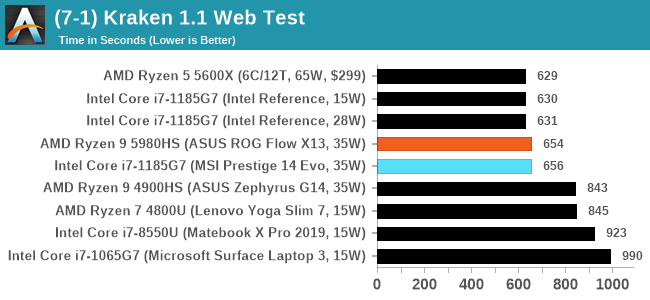
Google Octane 2.0
Our second test is also JavaScript based, but uses a lot more variation of newer JS techniques, such as object-oriented programming, kernel simulation, object creation/destruction, garbage collection, array manipulations, compiler latency and code execution.
Octane was developed after the discontinuation of other tests, with the goal of being more web-like than previous tests. It has been a popular benchmark, making it an obvious target for optimizations in the JavaScript engines. Ultimately it was retired in early 2017 due to this, although it is still widely used as a tool to determine general CPU performance in a number of web tasks.
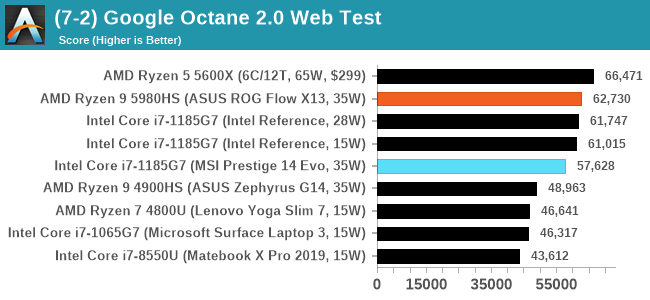
Speedometer 2: JavaScript Frameworks
Our newest web test is Speedometer 2, which is a test over a series of JavaScript frameworks to do three simple things: built a list, enable each item in the list, and remove the list. All the frameworks implement the same visual cues, but obviously apply them from different coding angles.
Our test goes through the list of frameworks, and produces a final score indicative of ‘rpm’, one of the benchmarks internal metrics.
We repeat over the benchmark for a dozen loops, taking the average of the last five.

Legacy Tests
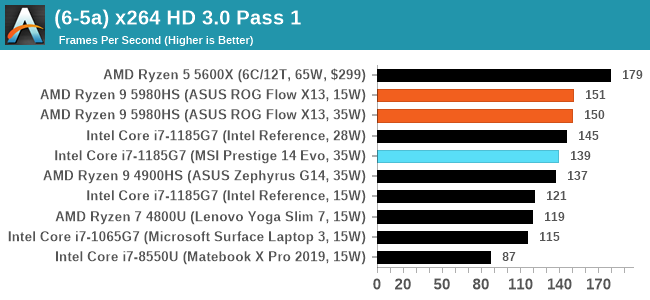
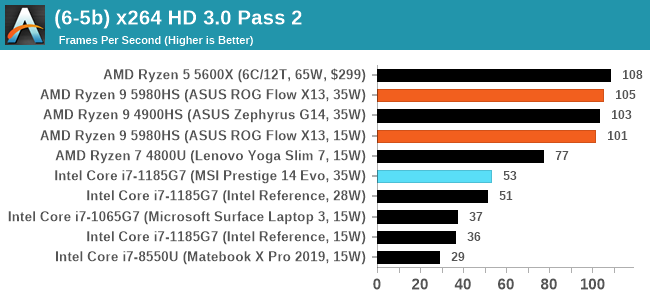
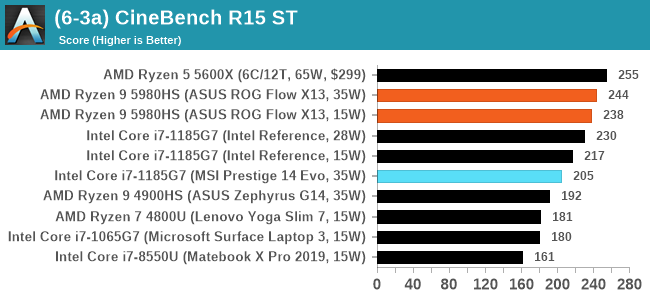
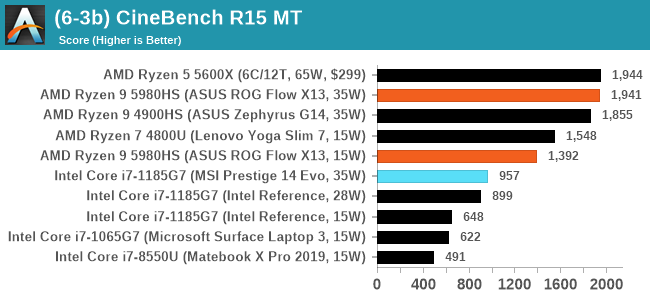


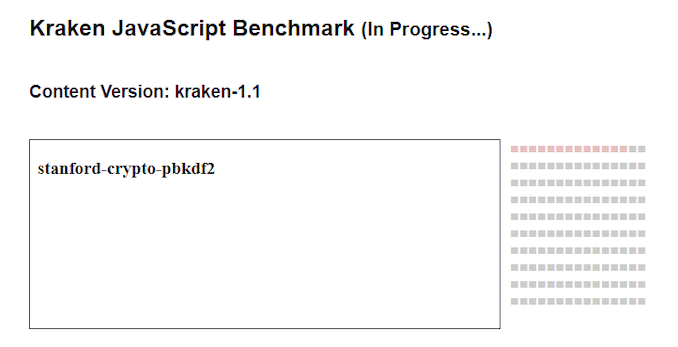
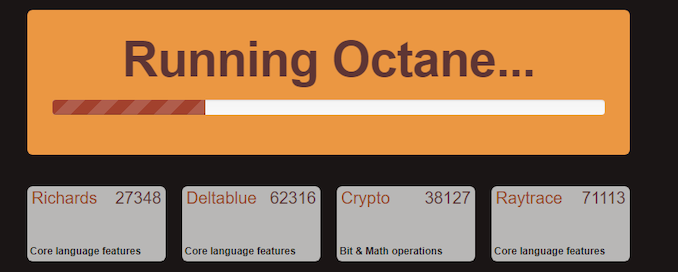









218 Comments
View All Comments
Samus - Wednesday, January 27, 2021 - link
The 1660Ti has a higher TDP than the entire POWER SUPPLY of these test systems...GeoffreyA - Wednesday, January 27, 2021 - link
"1660ti or better is mandatory for any decent gaming"The iGPUs are a blessing to many people, especially those on a slender budget, like myself. One can actually play games on these and have a lot of fun.
ZoZo - Tuesday, January 26, 2021 - link
Indeed I didn't base my statement on the results in this test. I thought I remembered seeing 15W Tiger Lake vs 15W Renoir giving an edge to Tiger Lake.yeeeeman - Wednesday, January 27, 2021 - link
this test is comparing a 35W part iGPU to a 15W part iGPU. 1185G7 beats 4800U iGPU..schujj07 - Wednesday, January 27, 2021 - link
The only 15W CPU in this iGPU test is that of the 4800U. The 1185G7 is 28-35W and the other Ryzen's are 35W. The 4900HS has a RAM speed deficiency on the 1185G7 and wins 4 out of 7 tests.mikk - Thursday, January 28, 2021 - link
Because they are mostly CPU bound, it's primarily a CPU test! Look at the resolution. Anandtech lowered the resolution to 360p-480p low details in some of them to give Vega a chance to beat Xe. Furthermore Vega needs to clock at 2100 Mhz, a 55% clock speed advantage. No AV1 decoding either which is another big flaw for a mobile device.Spunjji - Friday, January 29, 2021 - link
@mikk - Pretty sure those results still aren't CPU bound, otherwise they'd be in the 100+fps range - and you'd expect Intel to win under those circumstances, because of their high single-thread performance. If Intel's iGPU only "wins" when they're both running sub-30 fps then it's a fairly meaningless win."Vega needs to clock at 2100 Mhz" - irrelevant. High clocks is only a disadvantage if it leads to worse power consumption, and that's not the case here. If Intel can increase their clocks within the same power envelope then they should.
Lack of AV1 decoding is a downside. It's not clear yet whether it will be a major one, but it shows the age of AMD's solution.
dotjaz - Friday, February 5, 2021 - link
That's called competition, honey. Don't have to beat it.Spunjji - Thursday, January 28, 2021 - link
You could have read the review to see that's not true. Xe routinely loses to Vega 8 in actual games, albeit not by a significant margin.Tams80 - Monday, February 1, 2021 - link
Xe does beat it, no doubt. But it's still pretty close and for integrated graphics Vega is good enough for another year.As mentioned in the article, they probably used Vega again mainly to ensure a quick release.